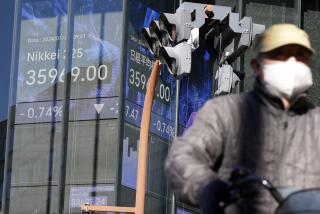Intel to Cut 4,000 Jobs in a Limp PC Market
Intel Corp., still reeling from one of the chip industry’s worst downturns, on Tuesday posted anemic earnings and announced it would cut 4,000 jobs, or about 5% of its work force, by the end of the year.
The cut, on top of 7,000 jobs eliminated last year, suggests the worst is not over for the world’s largest semiconductor maker.
“We were hoping to see the beginnings of an economic recovery,” said Intel Chief Financial Officer Andy Bryant. “We haven’t seen it.”
Chief Executive Craig Barrett announced the job cuts--which will include attrition and voluntary buyouts as well as layoffs--to Intel employees. The company, which has traditionally avoided large-scale staff reductions, has about 20,000 more employees than it did in 1999.
Emerging from a dismal 2001, Intel had joined numerous industry analysts in projecting a rebound in the second half of the year. But corporations have been reluctant to upgrade their computers. Intel, whose chips run eight out of 10 personal computers, relies on the strength of the PC market, which continues to sag.
“At the beginning of the year, they thought there would be a pickup in spending [on information technology] in the second half of the year,” said David Wu, vice president of research for Wedbush Morgan Securities in Los Angeles. “Now we’re in the second half, and it doesn’t look like it’s happening.”
Intel said revenue for the second quarter ended June 29 was $6.3 billion, down 7% from the first quarter and even with sales from the second quarter last year. Net income was $446 million in the second quarter, off 52% from the first quarter but up 127% from last year, when revenue and profit fell sharply.
Earnings per share, including the cost of acquiring new businesses, was 7 cents, up from 3 cents the same quarter last year but down from 13 cents a share in the first quarter. Excluding the acquisition costs, earnings were 9 cents a share, down 33% from last year and off 40% from the first quarter. The results, released after the close of the stock market, barely met Wall Street’s reduced expectations.
Intel shares fell 76 cents, or 4%, to $18.36 on Nasdaq in regular trading, then rose to $18.60 in after-hours trading, after the earnings report.
Intel, which now has 83,000 employees, said the cuts eventually would save Intel “hundreds of millions of dollars” a year.
But the move is viewed as a temporary fix.
“They’re just buying themselves a little more time for the tide to come in, and that tide is ... renewed spending,” Wu said, who estimates that companies next year will start to replace their old computers, many purchased in 1999 in anticipation of the so-called Y2K bug.
Although companies have typically waited three years to replace old machines, many are deciding to hold off even longer.
“Some of our clients in nonprofit, education and even government are looking to kick the machine out five, six and possibly seven years if they can do it,” said Mark Margevicius, a research director at Gartner Inc. “Obviously that’s not good news for Intel.”
With PC sales flagging, Intel has pared back businesses that executives deem unimportant to the company’s core expertise in semiconductors. For example, Intel this year stopped making toys and digital music players, and is phasing out its Web hosting business. At the same time, the chip giant has been trying to reduce its reliance on PCs by expanding its semiconductor offerings in other industries, such as cellular phones and mobile devices.
“There’s nothing Intel does that is wrong,” Margevicius said. “In fact, I like what they’re doing--getting back to silicon as their predominant focus.”






